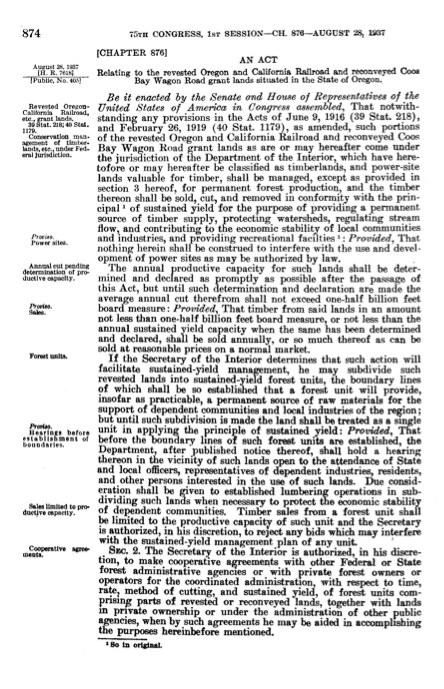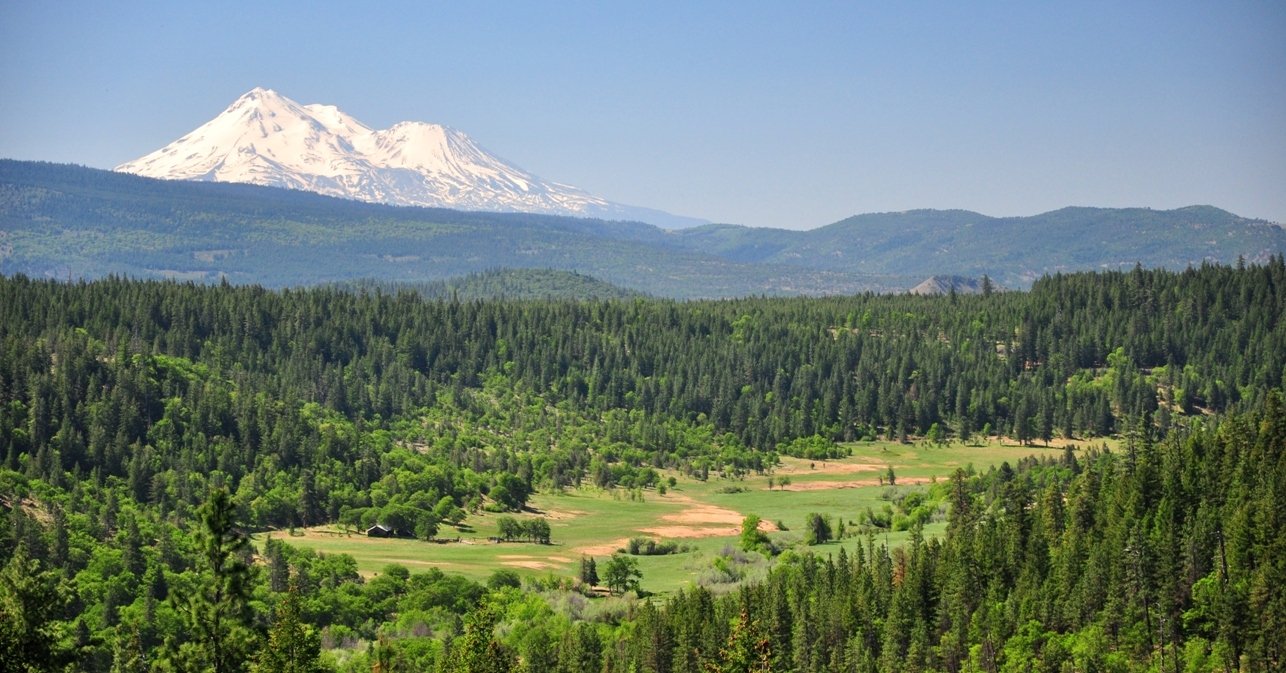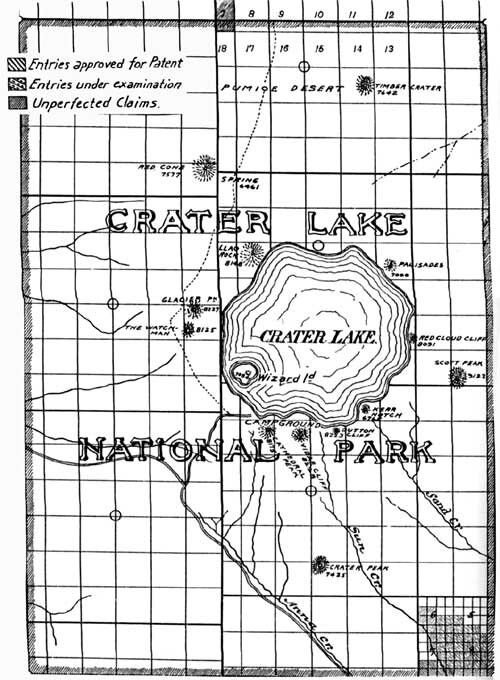This is the first in a series of four Public Lands Blog posts regarding the infamous “O&C” lands, a variant of public lands administered by the Bureau of Land Management in western Oregon. Part 1 sets the stage with a brief history and description of recent epochal events. Part 2 examines a recent ruling by the US Ninth Circuit Court of Appeals. Part 3 examines a recent ruling by the US District of Columbia Circuit Court of Appeals. Part 4 recommends repeal of the O&C Lands Act of 1937 and transferring administration of all BLM lands in western Oregon to either the Forest Service or the Fish and Wildlife Service.
Top Line: By letting stand two federal appeals court decisions, the US Supreme Court dealt a body blow—fatal, we can hope—to the Clearcut Conspiracy’s fantasy of holtz über alles (“timber above everything else”) on ~2.1 million acres of federal public forestland in western Oregon.
Figure 1. A rather small locomotive of the Oregon and California Railroad. Source: Bureau of Land Management.
Ever since I began my public lands conservation career during the Ford administration, a congressional statute enacted in 1937 “relating to the revested Oregon and California Railroad and reconveyed Coos Bay Wagon Road grant lands situated in the State of Oregon” has been the bane of my existence. In the mid-1970s, I discovered that the low-elevation old-growth-forested federal public lands just a few miles from where I grew up—and another 2.1 million acres administered by the Bureau of Land Management (BLM) in western Oregon—were not just your run-of-the-mill federal public lands but rather were exalted “O&C” lands.
According to my sources at the time, the O&C lands were the result of an Act of Congress so special that it effectively served as an 11th Commandment and a 26th (now 28th) Amendment. In all matters, the timber supremacy of the Oregon and California Lands Act (OCLA) of 1937 ruled! My sources of this information were the BLM, Big Timber, the western Oregon counties that received three-quarters of the timber revenues from the clear-cutting of old-growth forests (hereafter Addicted Counties), and all of Oregon’s congressional delegation (all collectively hereafter the Clearcut Conspiracy). Notice that I don’t list the judiciary as a source at that time—more on that later.
From 1937 until 1990, the Clearcut Conspiracy was successful with its holtz über alles narrative. Since the 1990s, especially during Democratic administrations, the BLM is no longer part of the conspiracy, but the agency still loves to log mature and old-growth forests and uses the OCLA as both a sword and a shield. Today, most members of the Oregon congressional delegation are not members of the Clearcut Conspiracy. The two unreconstructed holdouts are Representatives Cliff Bentz (R-OR-2nd) and Val Hoyle (D-OR-4th). (As to the latter, see this C-SPAN video [starting at 1:17:50] where Hoyle parrots the Clearcut Conspiracy’s talking points.)
Figure 2. The bane of my existence. Source: United States of America.
A Brief Synopsis of the O&C Lands
In 1866 Congress granted 3.7 million acres of public domain lands in western Oregon to facilitate the construction of a railroad from Portland to the California border. The Oregon and California Railroad line was built south as far as Medford before running out of money, at which point Southern Pacific Railroad took it over and finished the line into California.
Southern Pacific also sold huge blocks of the granted land to timber speculators. This violated the terms of the land grant, which specified the land could be sold only to bona fide settlers in 160-acre parcels for no more than $2.50 per acre. A series of lawsuits ensued, and eventually the Supreme Court directed that the granted lands that had not already been sold by the railroad into private ownership be returned to the government.
In 1916, Congress took back (after paying the Southern Pacific for them) the unsold 2.8 million acres of granted land and placed them under the jurisdiction of the General Land Office of the Department of the Interior. It further required that the General Land Office clear-cut these “Oregon and California Railroad Revested Lands” (a.k.a. O&C lands) as rapidly as possible and then sell first the timber and then the logged-off lands at auction.
Mostly the lands just remained in political and policy limbo, and in 1937 Congress enacted the Oregon and California Revested Lands Act (OCLA), a statute to retain in federal ownership the 2.7 million acres of land that were still unsold and manage them for multiple forest products (not just timber). The law also compensated sixteen western Oregon counties that could no longer collect property taxes on these again-federal lands.
The stage was set. Between 1937 and 1989, the Bureau of Land Management, successor to the General Land Office, and the rest of the Clearcut Conspiracy interpreted the 1937 statute as holtz über alles. Vast swaths of generally low-elevation old-growth forest were clear-cut and replaced with monoculture plantations of Douglas-fir.
Map 1. O&C lands administered by the BLM (dark orange), mostly in a checkerboard pattern with private timberland (white), some in a checkerboard pattern with BLM public domain land (yellow); “controverted” O&C lands administered by the US Forest Service (dark green), mostly in a checkerboard pattern with regular USFS lands (light green); Coos Bay Wagon Road (CBWR) lands administered by the BLM (burgundy). Source: Congressional Research Service.
In the early 1990s, multiple lawsuits to protect the northern spotted owl and other species resulted in dramatic drop-offs in O&C logging levels and payments to counties.
In 1995, President Clinton issued the Northwest Forest Plan (NWFP), which kept logging levels relatively low.
In 2016, the BLM abandoned the NWFP and continued with a management regime that resulted in the loss of mature and old-growth forests and trees but also kept logging levels relatively low compared to historical levels. The Clearcut Conspiracy (which the BLM and much of the Oregon congressional delegation were no longer a part of) sued.
In 2000, President Clinton proclaimed, pursuant to the Antiquities Act of 1906, the Cascade-Siskiyou National Monument, which included some infamous O&C lands. The Clearcut Conspiracy did not challenge the proclamation. In 2017, President Obama expanded the Cascade-Siskiyou National Monument to include more O&C lands. This time, the Clearcut Conspiracy did sue.
In 2024, the US Supreme Court let stand two 2023 decisions from two federal courts of appeal that found the Clearcut Conspiracy’s lawsuits to reimpose holtz über alles were without merit because that interpretation of the OCLA was wrong all along.
For more details on the history of the infamous O&C lands, see my Public Lands Blog post “Another Northwest Forest War in the Offing? Part 1: A Sordid Tale of Environmental Destruction, Greed, and Political Malfeasance.”
Figure 3. Old-growth logs are still coming off BLM holdings in western Oregon. Source: Bureau of Land Management.
The Lands at Issue
There are three variants of the “O&C” lands (Map 1):
1. O&C lands administered by the BLM, mostly in a checkerboard pattern with private timberland, some in a checkerboard pattern with BLM public domain land.
2. “Controverted” O&C lands administered by the US Forest Service (USFS), mostly in a checkerboard pattern with regular USFS lands.
3. Coos Bay Wagon Road (CBWR) lands administered by the BLM.
Under contention in the Clearcut Conspiracy suits were 2,084,884 acres of BLM O&C lands, lands revested from the land-grant-violating railroad. Also contested were the 74,547 acres of CBWR lands (Map 2), similarly reconveyed to the federal government for similar reasons at a similar time and administered the same as the O&C lands.
Map 2. The Coos Bay Wagon Road Lands, an even more obscure variant of federal public lands administered by the BLM.Source: Bureau of Land Management.
Somewhat in the mix, as they are intermixed with BLM O&C lands, were 394,578 acres of BLM generally forested public domain lands in western Oregon, lands that have never left the federal estate. For a long while, the BLM treated these western Oregon public domain lands the same as it treated its O&C lands.
Not under legal contention were the 492,000 acres of Forest Service O&C land shown in Map 1, which are national forest lands in every way except that counties benefit from these lands according to the O&C revenue-sharing formula rather than the regular national forest revenue-sharing formula.
Timber Above All Else?
It has long been the contention of the Clearcut Conspiracy that the OCLA outranks any other congressional statute, enacted prior or subsequent to 1937. Let’s drill down on that contention and see how the judiciary has responded. A basic rule of judicial interpretation of statutory construction is that if Congress intended a new statute to negate an existing statute, it would either repeal the older statute or explicitly say that it didn’t apply where the new statute applied. In a series of court cases from 1990 through the present, the judiciary has found that the OCLA doesn’t outrank other laws—especially, but not exclusively, those congressional statutes enacted after 1937.
Take, for example, these statutes subsequent to the OCLA of 1937: the Administrative Procedure Act of 1946 (APA), the National Environmental Policy Act of 1970 (NEPA), the Clean Water Act of 1970 (CWA), and the Endangered Species Act of 1972 (ESA) (all as amended). If Congress had meant to exempt the O&C lands from those later statutes, it would have said so when it enacted those statutes. Congress did not. Yet it took a series of court cases, starting in 1989, to conclude that APA, NEPA, CWA, and ESA all apply to O&C lands.
As for laws enacted prior to 1937, let’s consider the Antiquities Act of 1906, in which Congress granted power to the president to proclaim national monuments on federal lands. The Clearcut Conspiracy claimed that the OCLA precluded the proclamation of national monuments on any O&C lands that had any timber on them. Most recently, the courts found that the Antiquities Act does indeed apply to O&C lands. (See my previous Public Lands Blog post, “Cascade-Siskiyou National Monument: Safe from Big Timber, Threatened by the BLM.)
In only one statute, the Federal Land Policy and Management Act of 1976 (FLPMA) (as amended), did Congress address how that statute and the OCLA were to be reconciled. Section 701(b) of FLPMA says that the OCLA prevails over FLPMA “in the event of conflict with or inconsistency between this act and [the OCLA] . . . insofar as they relate to management of timber resources.” Then senior Oregon US senator Mark O. Hatfield (see my Public Lands Blog post “Mark Odom Hatfield, Part 1: Oregon Forest Destroyer”) made sure that this clause was included in FLPMA. Hatfield won and old forests lost.
Figure 4. The northern spotted owl, which requires old-growth forests for its survival. Source: Bureau of Land Management.
What Does the OCLA Actually Require?
What does the OCLA require of the BLM insofar as the 1937 statute relates to the “management of timber” on O&C lands? Remarkably, the courts had never clearly ruled on whether the OCLA itself contains an holtz über alles mandate. Between the BLM’s revising of western Oregon resource management plans in 2016 and President Obama’s expanding the Cascade-Siskiyou National Monument in 2017, the Clearcut Conspiracy went all in on a judicial strategy to, once and for all, determine that (1) the OCLA is exalted above all other statutes, and (2) the OCLA is understood as stipulating that logging should reign supreme over all other uses.
Over the many decades since 1937, the BLM’s own lawyers (“solicitors”) have opined to varying degrees at various times that the OLCA is a “dominant use” statute where logging is superior to other uses, rather than a multiple use statute where timber supply is one use equal to the other named uses of protecting watersheds, regulating stream flow, contributing to local economic stability, and recreation. In its 2016 plan revisions, the BLM essentially still interpreted the OCLA as timber first—but tempered by all those other congressional statutes, in particular ESA and CWA (but not FLPMA).
The Clearcut Conspiracy’s legal blitzkrieg consisted of a total of six lawsuits, five of which were filed in the US District Court for the District of Columbia. As the US Court of Appeals for the District of Columbia Circuit explains:
The appeals arise from three sets of cases filed by an association of fifteen Oregon counties and various trade associations and timber companies. Two of the cases challenge Proclamation 9564, through which the President expanded the boundaries of the Cascade-Siskiyou National Monument. Two others challenge resource management plans that the United States Bureau of Land Management (BLM), a bureau within the United States Department of the Interior (Interior), developed to govern the use of the forest land. The final case seeks an order compelling the Interior Secretary to offer a certain amount of the forest’s timber for sale each year.
The Clearcut Conspiracy won all five cases filed in the District of Columbia at the district court level, where the conspiracy had successfully shopped for a favorable judge, but then lost all on appeal to the appeals court.
As for the sixth lawsuit, the Murphy Company and Murphy Timber Investments, LLC, filed suit in the US District Court for the District of Oregon contesting the expansion of the Cascade-Siskiyou National Monument. Murphy lost at the district court level and also in the US Ninth Circuit Court of Appeals.
The Clearcut Conspiracy was left with just one more option: a hail-Mary pass to the nine members of the US Supreme Court seeking review of the six cases it lost. The Supremes declined. As I speculated previously, perhaps the destructive majority on the court felt that this O&C matter was small beer compared to all the other potential damage they want to do.
In the next two Public Lands Blog posts, I examine in detail the rulings of the US Ninth Circuit Court of Appeals (Part 2 of this series) and the US District of Columbia Circuit Court of Appeals (Part 3 of this series). I go so deep on these rulings because they make clear that the Clearcut Conspiracy’s fantasy that the OCLA of 1937 is a combo 11th Commandment and 28th Amendment is and always has been just that—a fantasy.
Figure 5. An adult coho salmon scaling Lake Creek Falls to return to its place of birth to spawn. Source: Bureau of Land Management.
Take a Bow
Special thanks are due to Kristen Boyles of Earthjustice and Susan Jane Brown, then mostly of the Western Environmental Law Center and now of Silvix Resources. These extraordinary lawyers represented “the wilds,” a.k.a. Oregon Wild, the Klamath-Siskiyou Wildlands Center, and Cascadia Wildlands. The several cases in two judicial circuits were as long and arduous as the stakes were high. The most able counsel of these two lawyers helped ensure that the courts eventually got it right.
For More Information
Blumm, Michael, and Tim Wigington. 2013. “The Oregon & California Railroad Grant Lands’ Sordid Past, Contentious Present, and Uncertain Future: A Century of Conflict.” Boston College Environmental Affairs Law Review.
Kerr, Andy. 2020. “Another Northwest Forest War in the Offing? Part 1: A Sordid Tale of Environmental Destruction, Greed, and Political Malfeasance.” Public Lands Blog.
———. 2020. “Another Northwest Forest War in the Offing? Part 2: Current Threats and Perhaps an Epic Opportunity.” Public Lands Blog.
Riddle, Anne A. 2023. “The Oregon and California Railroad Lands (O&C Lands): In Brief.” Congressional Research Service R42951.
Robbins, William G. “Oregon and California Lands Act.” Oregon Encyclopedia.
Scott, Deborah, and Susan Jane Brown. 2006. “The Oregon and California Lands Act: Revisiting the Concept of ‘Dominant Use’.” Journal of Environmental Law and Litigation.
United States Court of Appeals for the District of Columbia Circuit. July 18, 2023. American Forest Resource Council v. United States of America.
United States Court of Appeals for the Ninth Circuit. April 24, 2023. Murphy Co. v. Biden.



























